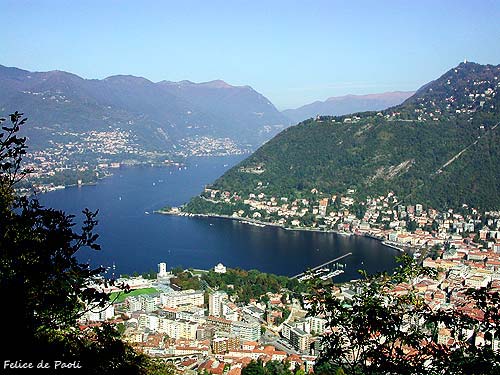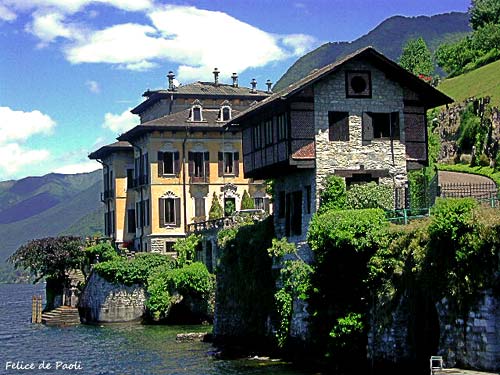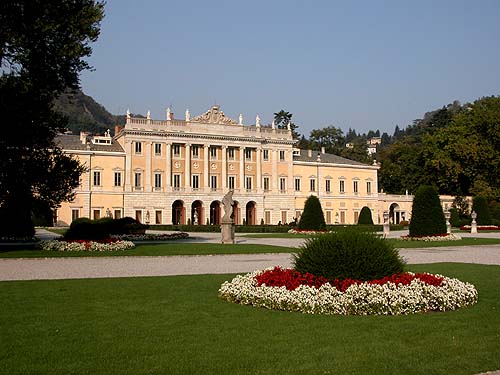
Como vista dal monte Croce.
Industria o turismo?
Como ha, allo stesso tempo, aspirazioni industriali e turistiche. L'industria
serica comasca si è fatta conoscere in tutto il mondo per l'alta qualità dei
prodotti ma certamente la bellezza del nostro lago non le è da meno.
Purtroppo le due cose non sempre sono conciliabili ed hanno delle
contropartite. Edifici industriali antichi e moderni deturpano alcune parti
della città e nelle domeniche soleggiate di primavera e d'autunno il lungo lago
è affollato a tal punto da rendere quasi impossibile persino la circolazione
pedonale.
Ma anche un comasco ormai antico, come me, non smette mai di apprezzare una
seduta rilassante al bar, in riva al lago, specialmente al tramonto quando le
barche ed i battelli rientrano e gli ultimi raggi del sole dipingono il cielo
con magnifici colori pastello.
Industry or tourism?
Como aims to be at the same time both industrial and touristic. The silk industry
of Como is renowned all over the world thanks to the high quality of its products
but what is more attractive is the beauty of its lake.
Unfortunately we can't afford these two aspects of the town without dealing with
problems. Old and modern industrial buildings are spoiling some areas of the
town and during spring time on the sunny Sundays the promenade is so crowded that
pedestrians can not walk easily.
But even a quite aged man from Como, like me, has never given up to appreciate a
restful break in a coffee bar on lake side, at sunset, when boats are going back
to the pier and the last rays of sunlight paint the sky with marvellous pastel
colours.

Ville sul lago.
(Il set di "Vivere")Un po' di storia
Como viene fondata dopo la conquista romana. Prima la convalle è disabitata o
con scarsi edifici, perché paludosa e soggetta ad esondazioni.
Ancora oggi, spesso si incontrano nel sottosuolo reperti del primo insediamento
e le forme dell'attuale tessuto urbano seguono, in gran parte, il tracciato
originale.
Le mura romane sono state sostituite nel XII° secolo da quelle che tutt'ora
racchiudono il centro storico.
Sin verso la fine dell'ottocento la città rimane dentro le mura espandendosi
negli ultimi cento anni sino a riempire tutta la convalle ed anche oltre.
About history
Como was founded after the roman conquest. In the beginning the valley was uninhabited
or it had few buildings, because it was marshy and with a lot of overflows.
Even today, we can find some archeological finds of the first settlement in the
underground and the shape of the current town draws on the original layout.
The roman walls were replaced during the twelfth Century and they still surround
the city center. The town was located within the walls until the end of the
nineteenth-century and only in the last hundred years it has been getting to
grow so much as to fill all the valley and even beyond it.

Villa Olmo.
Cittadini illustri
Caio Plinio Secondo, naturalista, al comando della flotta romana di capo
Miseno, muore aiutando la popolazione di Pompei durante l'eruzione. Una sua
statua orna la facciata del Duomo in notevole rilievo, sebbene pagano.
Alessandro Volta scopre l'elettricità che si misura in Volt in sua memoria. La
sua tomba è nel cimitero della località Camnago Volta. In città vi è il palazzo
dove è nato oltre ad un monumento ed un tempio a lui dedicati.
Giuseppe Terragni, architetto, nel 1936 progetta la Casa del Fascio di Como, un
importante esempio di architettura razionalista pura.
Famous citizens
The naturalist Caio Plinio Secondo died when he was in command of the roman fleet
by Misino Cape. He was helping the people of Pompei during the volcanic eruption.
Even if he was pagan his statue distinctly embellishes the front of the cathedral.
Alessandro Volta discovered electricity and since then it's measured in Volt. His
grave is in the cemetery in Camnago Volta, while the palace where he was born, is
in the town, where you also found a temple and a monument dedicated to him.
The architect, Giuseppe Terragni, planned the "Casa del fascio", in Como, an
important example of pure rationalistic architecture.

Tempio Voltiano.
Edifici e monumenti
Il Duomo, iniziato nel 1396 e finito nel 1744, affiancato dal Broletto, sorto
nel 1215 e dalla torre civica.
La basilica di San. Carpoforo, IV° secolo
La basilica di San. Abbondio, XI° secolo.
La basilica di San. Fedele, XII° secolo.
Il Castel Baradello e le torri medievali, XI° secolo.
Il Tempio Voltiano, 1927.
Il monumento ai caduti disegno dell'arch. Sant'Elia, 1930.
La Casa del Fascio progetto dell'arch. Terragni, 1936.
Fontana di Camerlata, 1960.
Buildings and monuments
The Duomo was built in 1396 and finished in 1744. Next to it we can find the Broletto, built in 1215 and the municipal tower.
The Basilica of S.Carpoforo, ( fourth Century )
The Basilica of S. Abbondio, ( eleventh Century )
The Basilica of S.Fedele, ( twelfth Century )
The Baradello Castle and the medieval towers, ( eleventh Century )
The Voltiano Temple, 1927
The war memorial designed by the architect Sant’Elia in 1930
The "Casa del Fascio" planned by the architect Terragni in 1936
The Camerlata fountain, 1960
Da piazza Cavour a villa Olmo
Vedi
Si tratta di una interessante passeggiata a lago, percorribile sia a piedi che
in bicicletta, che attraversa ricche ville pluricentenarie, in uno scenario
bellissimo.
Si lascia piazza Cavour in direzione ovest. Seguendo il cantiere per le nuove
paratie, si arriva ai giardini pubblici, dove, di fronte al monumento alla
resistenza europea, sorge la diga foranea che si lancia nel lago permettendo di
vedere la città dall'acqua.
Passato il tempio voltiano ed il monumento ai caduti si raggiunge l'Aeroclub
Como, sede di una importante scuola di volo per idrovolanti.
Una pedonale costruita negli anni '60 prosegue per villa Olmo passando davanti
ad una serie di nobili ville tra le quali spiccano la "Rotonda" e la "Gallia"
attualmente sedi dell'amministrazione provinciale.
Villa Olmo, edificata nel 1780 dall'architetto Simone Cantoni per il marchese
Odescalchi, attualmente di proprietà comunale, ha accolto personaggi celebri
come Napoleone, Foscolo, Metternich e Garibaldi. Nelle sale e nel parco vengono
organizzate molte mostre e spettacoli.
Per chi lo volesse la passeggiata prosegue fino a Cernobbio, giungendo sino nel
pressi della magnifica villa d'Este, che deve questo suo nome ottocentesco a
Carolina di Brunswick, regina d'Inghilterra.
From piazza Cavour to Villa Olmo
Look
This interesting promenade, where we can walk along or cycle, follows the lake
side and crosses rich ancient villas in a magnificent landscape.
We leave Cavour square walking to west. Following the building site of
the new bulkheads, we get to the public gardens where, opposite the European resistance
monument, there is a dam in the lake. Here we can see the town from the water.
After the voltiano temple and the war memorial we get to the Como flying club. An
important seaplane piloting school.
We can go on to villa Olmo walking along a pedestrian street. It was built in the
sixties and it passes by a lot of aristocratic villas such as: la Rotonda and la Gallia.
They are the provincial government offices.
Villa Olmo was built in 1780 by the architect Simone Cantoni for the Odescalchi marquess.
Now it is a municipal property and it has been given hospitality to some famous figures
as Napoleone, Foscolo, Metternich and Garibaldi. Furthermore in its halls and in the park
are mounted exhibitions and performances.
If we wish to go on the promenade we can get to Cernobbio to visit the magnificent Villa
D’Este, named after Caroline von Brunswick, queen of England.